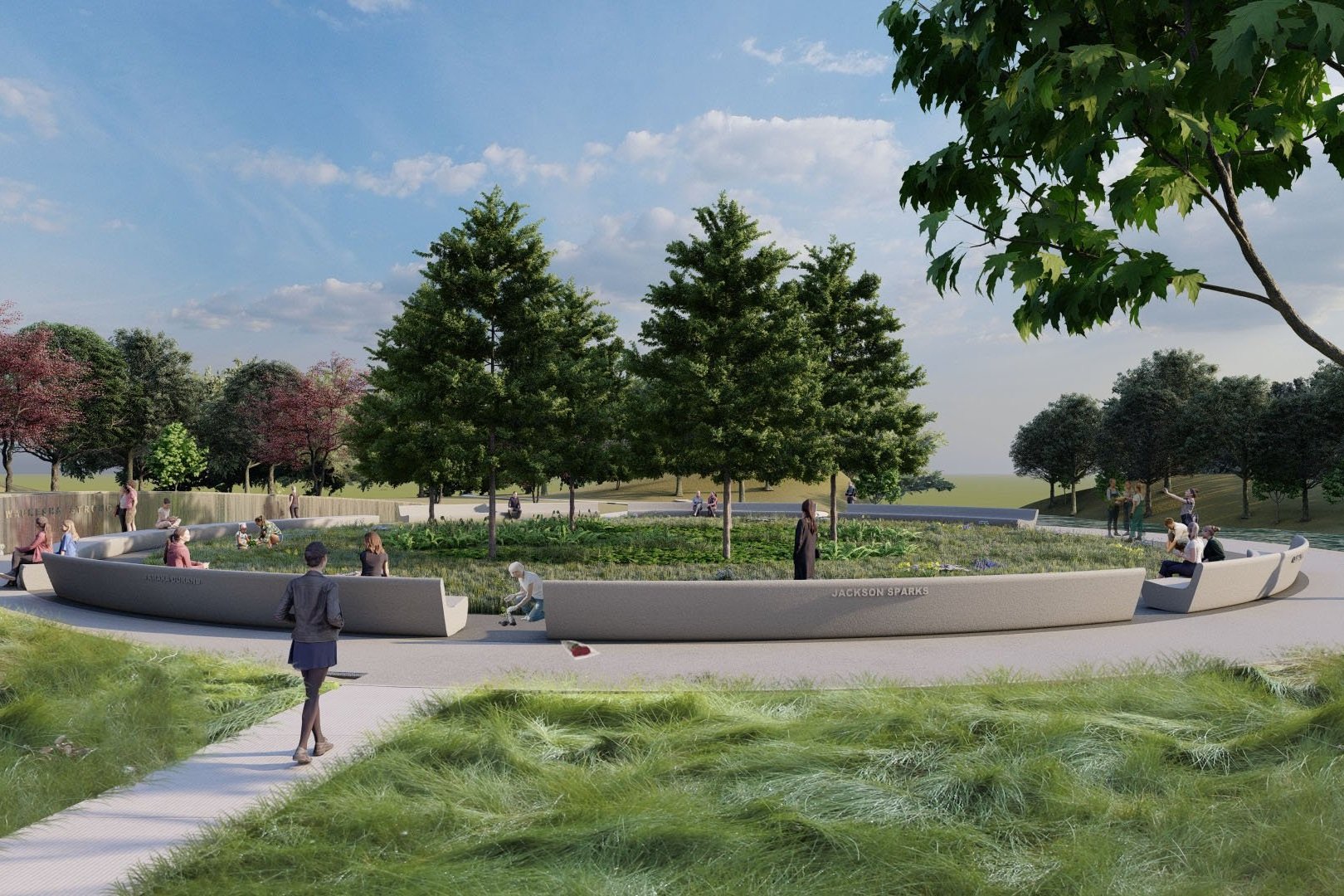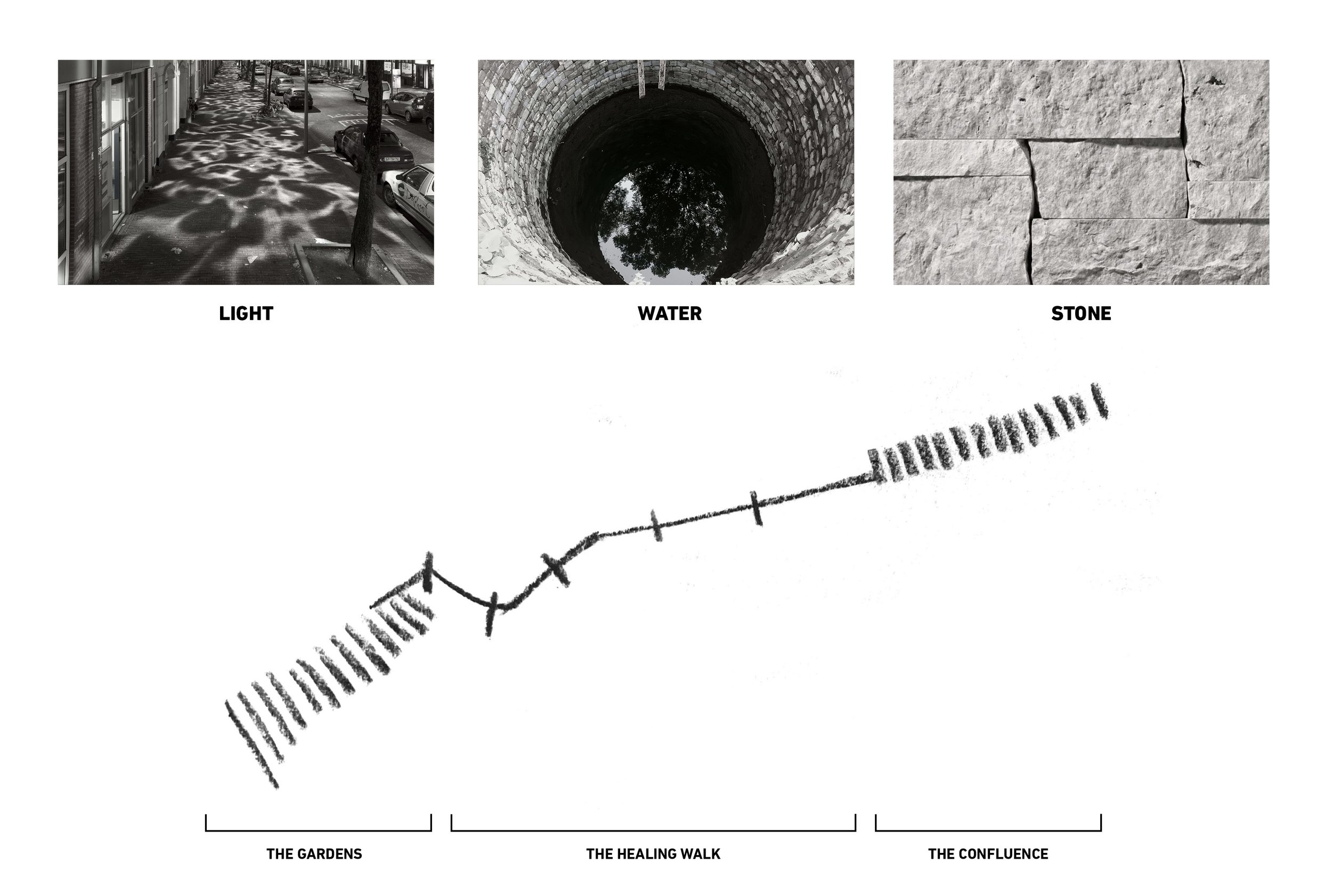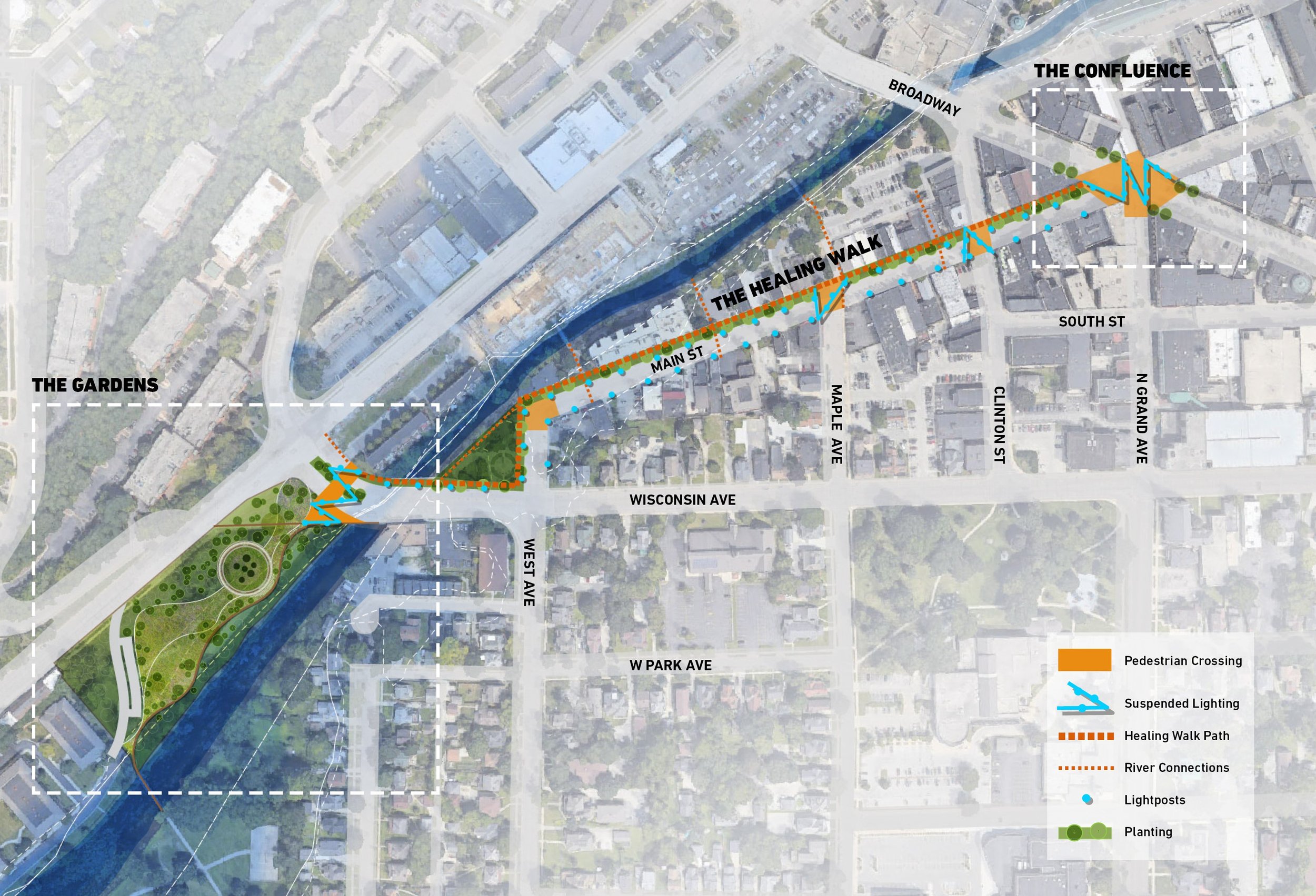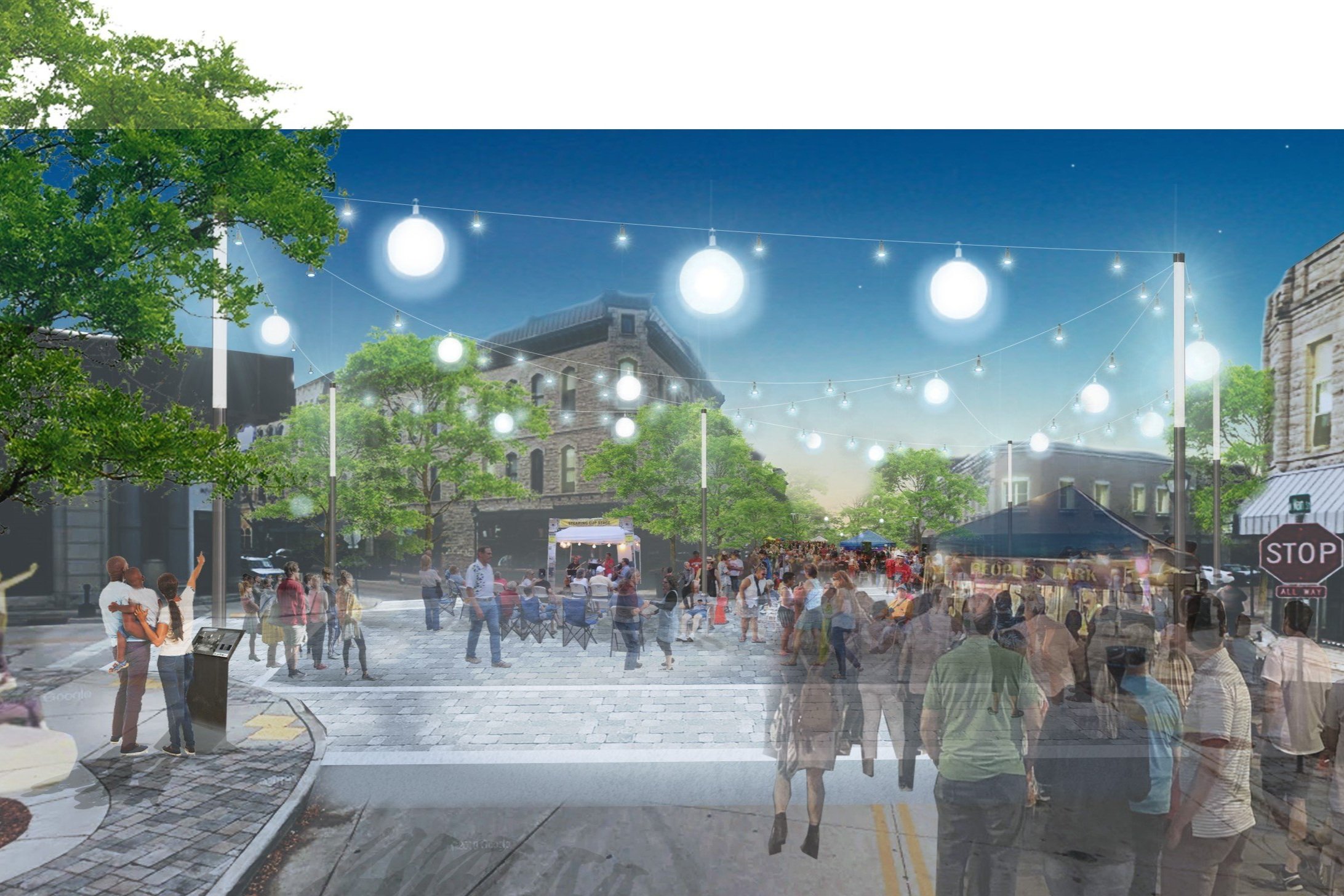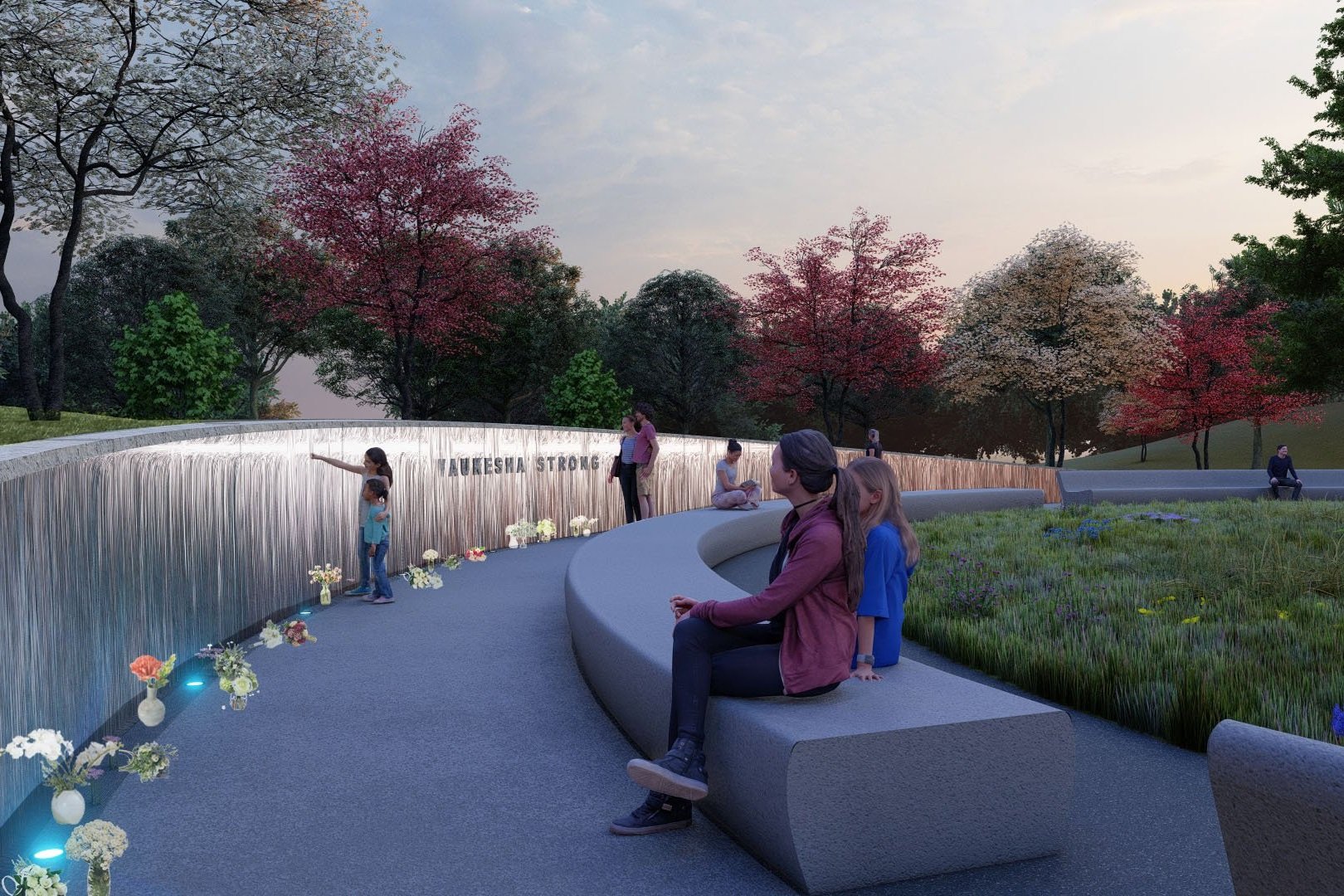WAUKESHA PARADE MEMORIAL
Location: Waukesha, Wisconsin
Status: Unbuilt
Team: TEN x TEN
Awards: 2023 ASLA Minnesota Merit Award for UnBuilt Works
SITE + COMPETITION PROMPT
The competition prompt posed by the Waukesha community presented an interesting challenge, to create two memorials at two complex and distinct locations. The first site, at the Five Points intersection where the parade was struck, is on busy Main Street, with two-way traffic, double-sided parking, and narrow sidewalks. The second site, Grede Park, located a half mile southwest of the parade site, is an existing park defined by open lawn, limited river access, and vehicular traffic passing through.
How can a memorial span across a city and reclaim the street? The Waukesha, WI community asked designers to propose a memorial design in honor of the six victims killed and many more injured when a man intentionally drove his vehicle into the crowded, annual Waukesha Christmas Parade. This proposal interprets the request for two memorial locations, one at the parade site and one at a nearby park, as an opportunity for procession and remembrance between these two spaces. The Waukesha Parade Memorial honors the victims through action, by reclaiming the street and creating a safer, pedestrian-friendly landscape.
THE PROCESS
As the hometown to our Principal, Ross Altheimer, the team had a distinct advantage in understanding the history and cultural context as well as a deeply personal connection to the project. Our process began with a deep dive into this history, adjacent assets, and the people who this memorial should honor. The Fox River, which passes between the two sites, was a particular focus, and we saw this memorial as part of a larger network of public spaces connected by the river and trails. Street level analysis also helped to inform the recommendations for improvements to the pedestrian experience.
Historical Context
A century ago, Waukesha was known as Spring City because of its many springs. Records show the presence of more than 50 springs within the City of Waukesha, and more were scattered around the county.
Relationship to Water
Our studies of the street extended to the river to understand relative elevation and proximity to the river and what relationship the pedestrian could have with water along the walk.
APPROACH
As a landscape-led team, our approach was to consider the urban fabric as a part of the memorial. Through this memorial we envisioned transforming the street into a space people can walk without fear and with dignity, by creating streets that feel welcoming and safe to pedestrians daily as well as during annual events and parades. Giving power to the pedestrian is an important symbol of resilience of the Waukesha community and a message of strength and unity.
Grief and healing are not linear experiences. Like gardens, healing requires attention and tending, growth and care. Plants, stone, water, and light are representative of strength and healing, showing the capacity to grow together. Waukesha’s springs have long been a destination for healing, including at Grede Park, making this an instinctual place for the community to collectively heal after the enormous trauma experienced together.
Conceptual Drivers
The cultural significance of materials—light (blue light used by the community after the tragedy), water (local healing spring waters), and stone (local limestone)—act as symbols of strength, safety, healing, and unity. Two distinct spaces, a park, and a vehicular intersection, are threaded together with these three mediums.
DESIGN PROPOSAL
Our proposal identifies a walk that traces the parade route and links together The Confluence at the Five Points and The Gardens at Grede Park. A memorial that reclaims the street and unites the community were the primary driving forces of the project. Our design proposal reconsiders the memorial tradition toward a more active and restorative approach. This memorial suggests that memorializing does not require a static or singular site, but rather can invite visitors to honor the victims of this tragedy by walking, planting, gathering, engaging, and reflecting across the city of Waukesha.
THE HEALING WALK
Beginning at the parade start, the Five Points, the Healing Walk reimagines Main Street as a space for gathering, honoring, celebration, and movement. Safe, vibrant pedestrian crossings along this procession are an active celebration of those who lost their lives and the people who continue to live here.
THE CONFLUENCE
The Healing Walk begins at the start of the parade route at the Five Points intersection. At the Confluence, a series of catenary lights suspended over the intersection at Main Street and West Broadway indicate the significance of this space. Lighting and expanded pedestrian crossings extend along the parade route towards the memorial gardens. On important anniversaries and special events, the lights shine blue to honor the victims. As the site of immense trauma, the Confluence at the Five Points of Main Street is a space for gathering, honoring, celebration, and movement. Safe, vibrant pedestrian crossings along this procession are an active celebration of those who lost their lives and the people who continue to live here.
THE GARDENS
At the terminus of the Healing Walk is a series of memorial gardens located at Grede Park. The primary entrance at the Washington Bridge is preserved for pedestrian access to the memorial by redirecting Riverwalk Drive to exit on West St. Paul Avenue, removing vehicular traffic from the memorial. A series of meandering garden paths and a boardwalk following the new naturalized edge of the Fox River all lead to a sunken circular Healing Garden at the center of the park. Limestone benches around the garden allow people to gather or have solitary reflection. The garden is set just above the flood elevation and the water-loving plantings are cared for by the community.
Within the sunken Healing Garden, a cluster of six evergreen trees honor the six victims. In winter, these trees keep their foliage and lights illuminate them for the Christmas Parade. The surrounding planting is a community-led healing garden of grasses and perennials. Six memorial benches honor the victims: Tamara, Jane, Wilhelm, Leanna, Virginia, and Jackson.
On the north side of the sunken garden, a water wall retains the slope. Water runs down the face of the wall, providing a calming sound and cooling presence. The names of the victims are etched into the walls surface, washed by the water.
Stormwater Infiltration
The sunken garden engages with water in a variety of ways, from pragmatic to aesthetic. Runoff from St. Paul Avenue flows downhill and is diverted from the Fox River by infiltration gardens. The existing hard edge of the river is softened along the memorial boardwalk to accommodate flooding.
Engaging with Water
The form and material of the circular sunken garden references the deep history of natural springs used for healing and wellness. Natural springs were once thoughtfully celebrated with vernacular stone wells, and the Garden’s design is a nod to this history.

